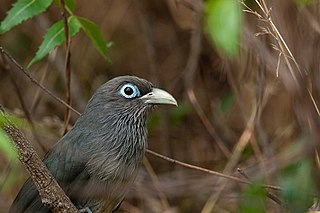
The common cuckoo is a member of the cuckoo order of birds, Cuculiformes, which includes the roadrunners, the anis and the coucals.

Prinia is a genus of small insectivorous birds belonging to the passerine bird family Cisticolidae. They were at one time classed in the Old World warbler family, Sylviidae.

The blue-faced malkoha or small green-billed malkoha, is a non-parasitic cuckoo found in the scrub and deciduous forests of peninsular India and Sri Lanka. It has a waxy, dark, blue-grey plumage on its upperparts and has a long tail with graduated white-tipped feathers. The throat and chin are dark with spiny pale feathers that are branched. The lower belly is a dull creamy to rufous colour. The bill is apple green, and a naked patch of blue skin surrounds the eye. The sexes are alike. The blue-faced malkoha is a bird of open forests and scrub jungle.

The plain prinia, also known as the plain wren-warbler or white-browed wren-warbler, is a small cisticolid warbler found in southeast Asia. It is a resident breeder from Pakistan and India to south China and southeast Asia. It was formerly included in the tawny-flanked prinia, resident in Africa south of the Sahara. The two are now usually considered to be separate species.

The jungle prinia is a small passerine bird, a warbler in the family Cisticolidae.

The ashy prinia or ashy wren-warbler is a small warbler in the family Cisticolidae. This prinia is a resident breeder in the Indian subcontinent, ranging across most of India, Nepal, Bangladesh, eastern Pakistan, Bhutan, Sri Lanka and western Myanmar. It is a common bird in urban gardens and farmlands in many parts of India and its small size, distinctive colours and upright tail make it easy to identify. The northern populations have a rufous rump and back and have a distinct breeding and non-breeding plumage while other populations lack such variation.

The broad-tailed grassbird is a species of Old World warbler in the family Locustellidae. It is endemic to the Western Ghats of India with a possibility of occurrence in Sri Lanka. A small, mostly brown bird, it has a broad rounded and graduated tail. It is found only on the higher altitude grassy hills where it usually skulks, except during the breeding season when males fly up into the air to sing in their display. The species is believed to be a resident although it is possible that they make local movements.

The rufous-eared warbler is a species of bird in the family Cisticolidae. It is found in Botswana, Namibia, and South Africa. It is the only species in the genus Malcorus. Its natural habitats are subtropical or tropical dry shrubland and subtropical or tropical dry lowland grassland.

The cricket warbler, also known as cricket longtail, scaly longtail or cricket prinia, is a species of bird in the family Cisticolidae. It belongs to the genus Spiloptila; it is often the only species included in the genus but sometimes the red-fronted prinia is placed there as well.
The swamp grass babbler or swamp prinia is a small bird of the Indian subcontinent. Some authorities consider it a subspecies of the rufous-vented grass babbler.












